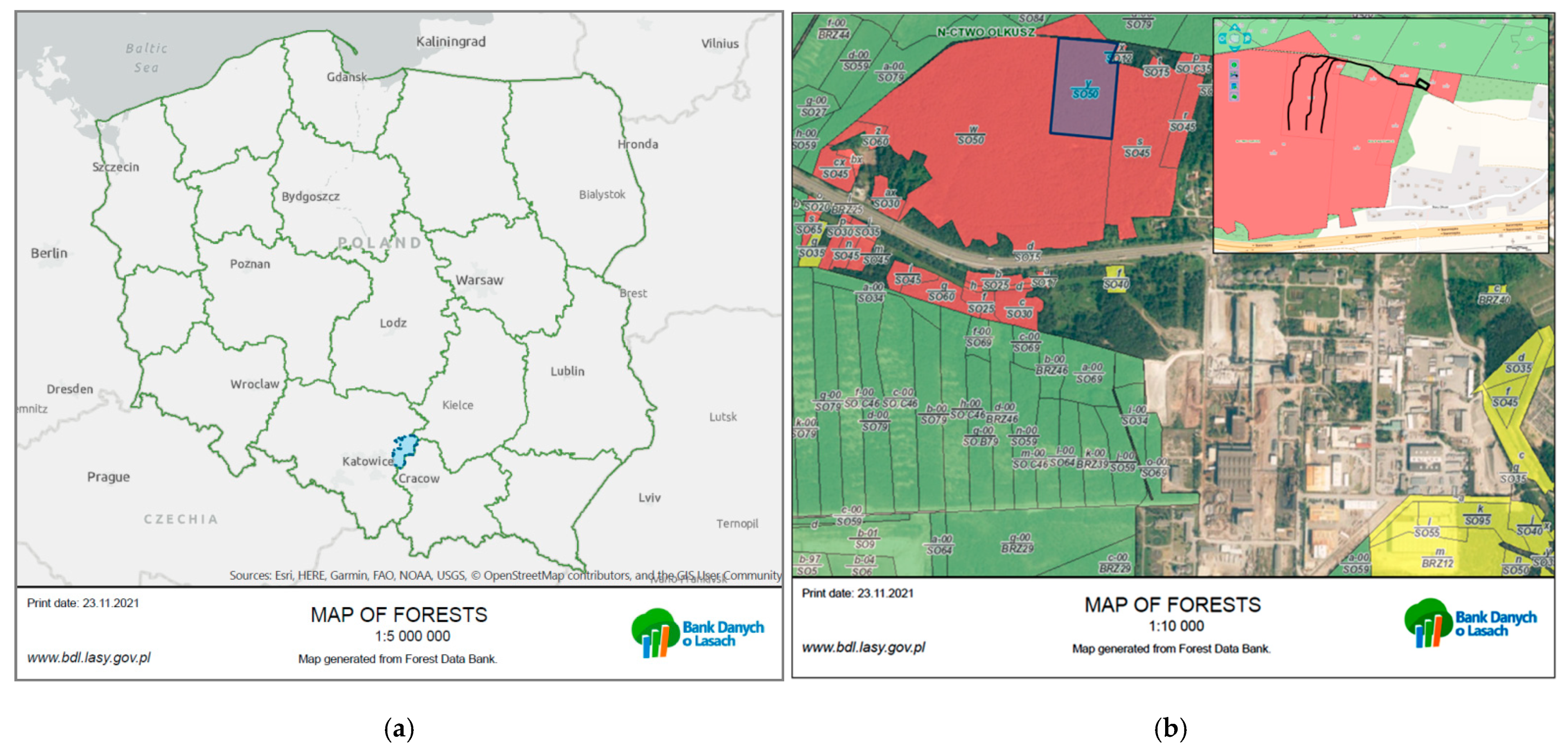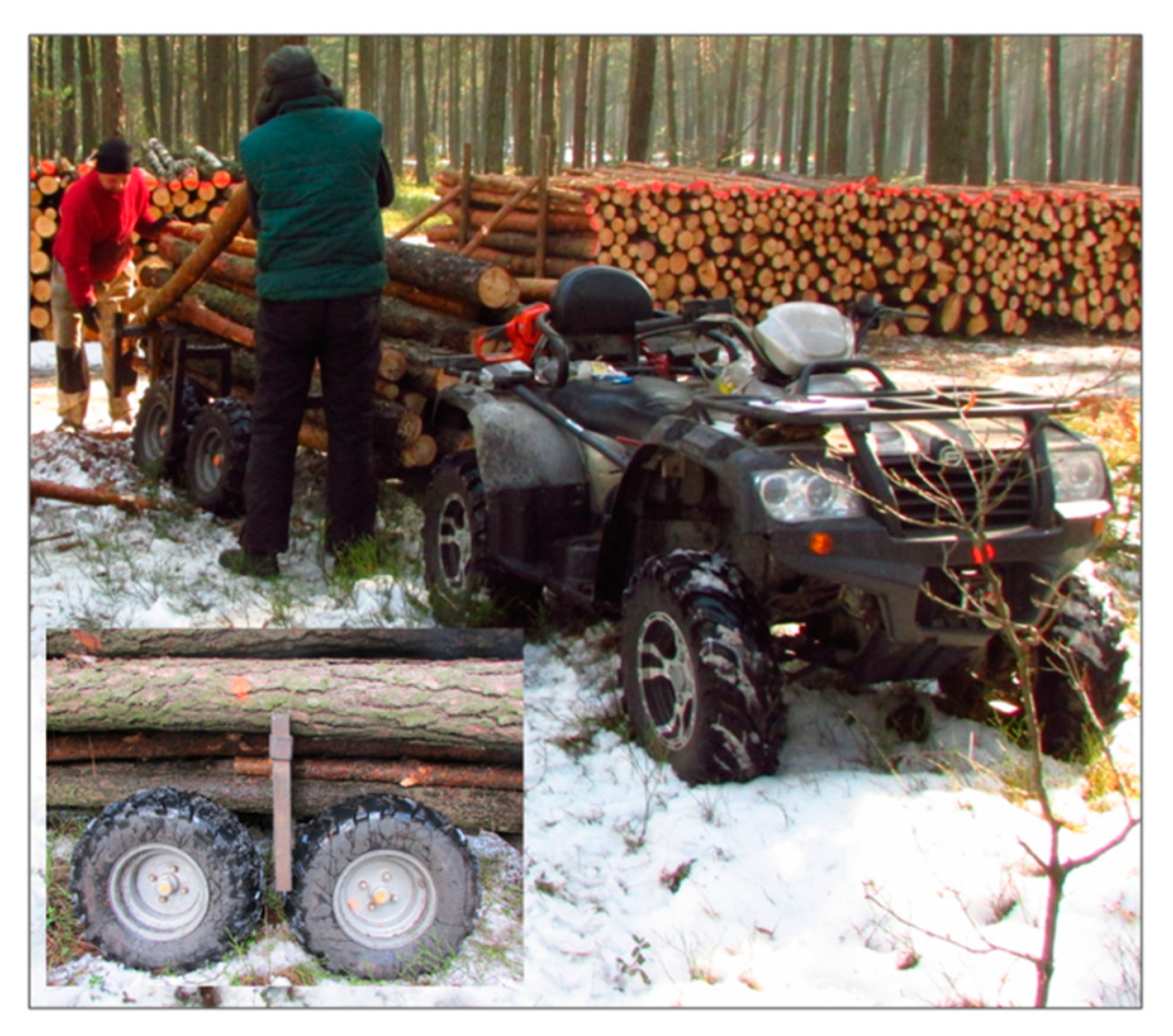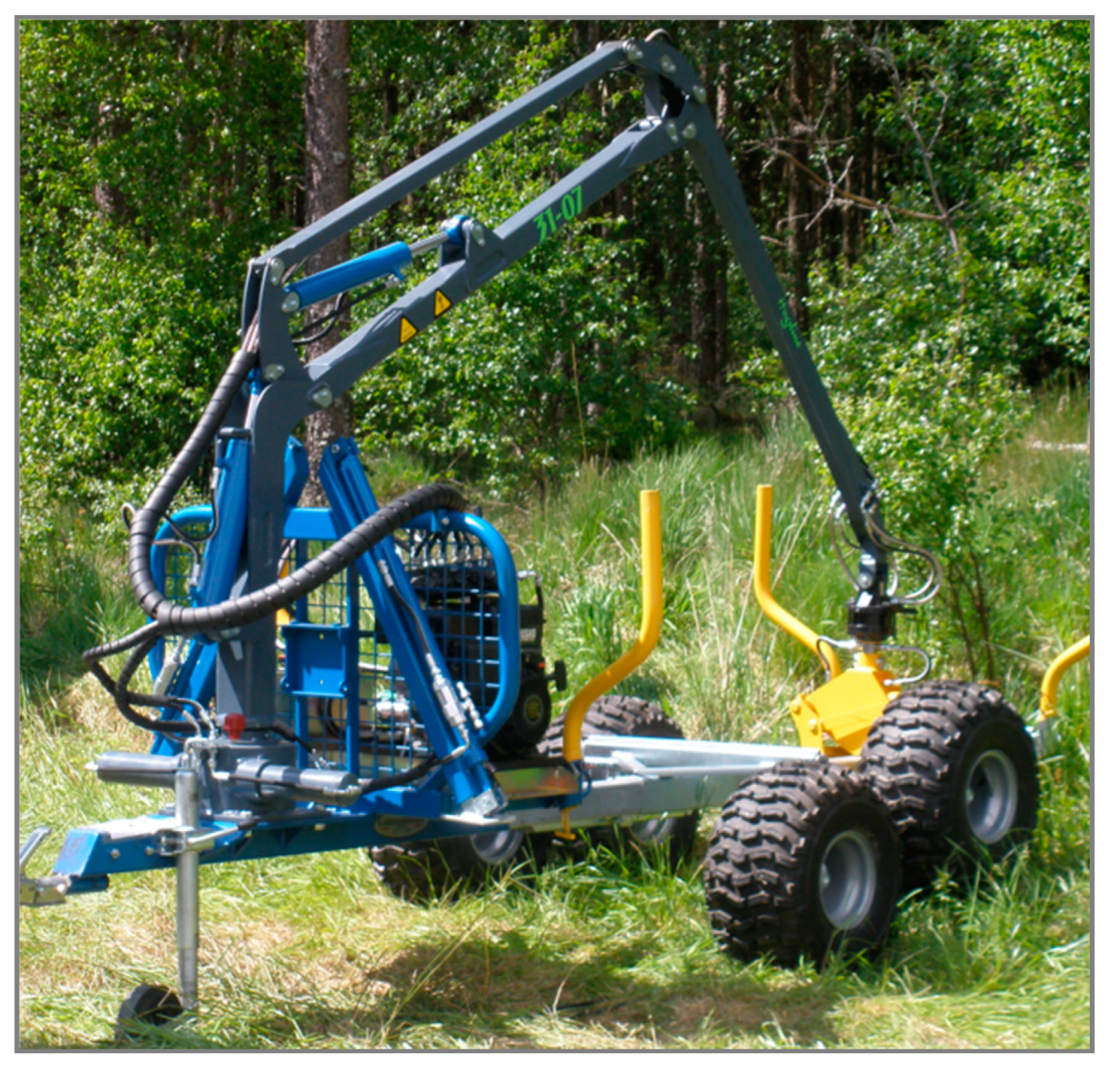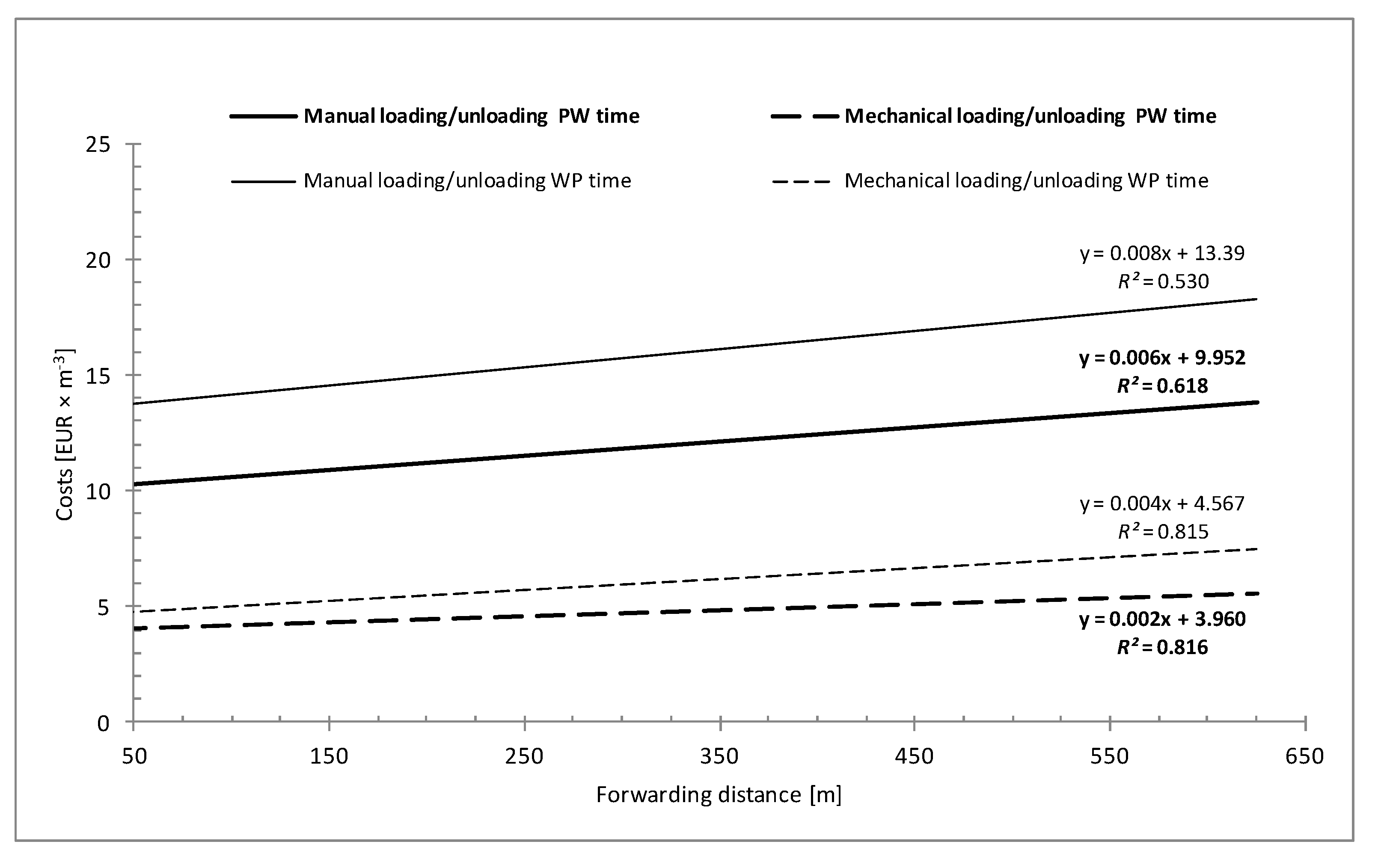Effectiveness and Injury Risk during Timber Forwarding with a Quad Bike in Early Thinning
Abstract
:1. Introduction
2. Materials and Methods
- non-work time (NT), which included:
- ✓
- breaks for eating restorative meals, warming up by the fire, and drying soggy outer clothing and work gloves (mealtime, ME);
- ✓
- rest periods before or after manual loading or unloading of timber and short breaks for physiological needs, telephone conversations, and smoking (rest and personal time, RP);
- work time (WT), which included:
- ✓
- productive work time (PW), which included:
- ○
- time of timber loading and unloading (including time of unfolding and folding the trailer’s supports), time of timber forwarding (full load) to the landing (main work time, MW), and
- ○
- time of unloading rides from the landing to the cutting area (rides without load), time of rides between the individual stages of timber loading (rides during loading), and time of placing timber pads and securing the piles against shifting to the sides (pile-place preparing) (complementary work time, CW),
- ✓
- supportive work time (SW), which included:
- ○
- time to repair a failure related to the tightening of the trailer wheel, fixing bolts (repair time, RT),
- ○
- time spent refueling (refuel time, RF), and
- ○
- time taken for checking and servicing the basic components of the unit used for checking the pressure in the trailer wheels or lubrication state of the joints (maintenance time, MT).
3. Results
3.1. Work Time Structure
3.2. Forwarding Productivity for Manual Loading and Unloading
3.3. Forwarding Productivity for Mechanical Loading and Unloading
3.4. Costs of Timber Forwarding
3.5. Risk of Musculoskeletal Strain
4. Discussion
4.1. Work Time Structure
4.2. Productivity of Manual Loading and Unloading
4.3. Productivity of Mechanical Loading and Unloading
4.4. Costs of Timber Forwarding
4.5. Injuries’ Risk
5. Conclusions
Author Contributions
Funding
Institutional Review Board Statement
Informed Consent Statement
Data Availability Statement
Conflicts of Interest
References
- Harrison, S.; Herbohn, J.; Niskanen, A. Non-industrial, smallholder, small-scale and family forestry: What’s in a name? Small Scale For. Econ. Manag. Policy 2002, 1, 1–11. [Google Scholar] [CrossRef] [Green Version]
- Lindroos, O.; Lidestav, G.; Nordfjell, T. Swedish non-industrial private forest owners: A survey of self-employment and equipment investments. Small Scale For. Econ. Manag. Policy 2005, 4, 409–425. [Google Scholar] [CrossRef] [Green Version]
- Gołos, P. Private forests in Poland—The results of the questionnaire surveys covering the network of test forest holdings. Folia For. Pol. 2011, 53, 25–42. [Google Scholar]
- GUS. Statistical Yearbook of Forestry; Główny Urząd Statystyczny Statistics Poland: Warsaw, Poland, 2020.
- Herbohn, J. Small-Scale Forestry—Is It Simply a Smaller Version of Industrial (Large-Scale) Multiple Use Foresty? Small Scale For. Rural. Dev. Intersect. Ecosyst. Econ. Soc. 2006, 158–163. [Google Scholar]
- Glazar, K.; Maciejewska, H. Struktura czasu i wydajność pozyskiwania i zrywki drewna w drzewostanach sosnowych przy użyciu harwardera Buffalo Dual. Inżynieria Rolnicza 2008, 12, 111–118. [Google Scholar]
- Mederski, P. A comparison of harvesting productivity and costs in thinning operations with and without midfield. For. Ecol. Manag. 2006, 224, 286–296. [Google Scholar] [CrossRef]
- Mederski, P.; Bembenek, M.; Karaszewski, Z.; Lacka, A.; Szczepanska-Alvarez, A.; Rosinska, M. Estimating and modelling harvester productivity in pine stands of different ages, densities and thinning intensities. Croat. J. For. Eng. 2016, 37, 27–36. [Google Scholar]
- Mederski, P.; Venanzi, R.; Bembenek, M.; Karaszewski, Z.; Rosinska, M.; Pilarek, Z.; Luchenti, I.; Surus, M. Designing thinning operations in 2nd age class pine stands economic and environmental implications. Forests 2018, 9, 12. [Google Scholar] [CrossRef] [Green Version]
- Moskalik, T. Rozwój technik i technologii maszynowego pozyskiwania drewna (Development of machine technologies within timber harvesting). Sylwan 2002, 146, 31–37. [Google Scholar]
- Moskalik, T.; Borz, S.A.; Dvořak, J.; Ferencik, M.; Glushkov, S.; Muiste, P.; Lazdiņš, A.; Styranivsky, O. Timber harvesting methods in Eastern European countries: A review. Croat. J. For. Eng. 2017, 38, 231–241. [Google Scholar]
- Więsik, J. Urządzenia Techniczne w Produkcji Leśnej. Tom 2—Maszyny i Urządzenia do Pozyskiwania i Transportu Drewna (Technical Devices in Forest Production. Vol. 2. Machines and Devices for Timber Harvesting and Transportation), 1st ed.; Wydawnictwo SGGW: Warszawa, Poland, 2015; Volume 2. [Google Scholar]
- Mederski, P.S.; Borz, S.A.; Duka, A.; Lazdins, A. Challenges in forestry and forest engineering—Case studies from four countries in East Europe. Croat. J. For. Eng. 2021, 42, 117–134. [Google Scholar] [CrossRef]
- Sowa, J.; Kulak, D.; Szewczyk, G. Costs and efficiency of timber harvesting by NIAB 5-15 processor mounted on a farm tractor. Croat. J. For. Eng. 2007, 28, 177–184. [Google Scholar]
- Leszczyński, K.; Stańczykiewicz, A. Workload analysis in logging technology employing a processor aggregated with a farm tractor. For. Syst. 2015, 24, 8. [Google Scholar] [CrossRef] [Green Version]
- Gorzelak, A. Gospodarowanie w Lasach Drobnej Własności (Management within Private Forests), 1st ed.; Forest Research Institute: Warszawa, Poland, 2001. [Google Scholar]
- Marenče, J.; Krč, J. Possibilities of using small tractors for forestry operations on private property. Croat. J. For. Eng. J. Theory Appl. For. Eng. 2016, 37, 151–162. [Google Scholar]
- Stańczykiewicz, A. Prawdopodobieństwo Wystąpienia Szkód w Odnowieniach Podokapowych Wskutek Pozyskiwania Drewna oraz Model ich Szacowania (The Probability of Occurrence of Damage to Regeneration under Canopy due to Timber Harvesting and The Model of its Evaluating), 1st ed.; Zeszyty Naukowe Uniwersytetu Rolniczego im. Hugona Kołłątaja w Krakowie: Kraków, Poland, 2018; Volume 541. [Google Scholar]
- Szewczyk, G. Czasochłonność zrywki drewna wyciągarkami zagregowanymi z pilarkami spalinowymi w drzewostanach trzebieżowych. Sylwan 2011, 155, 401–412. [Google Scholar]
- Savelli, S.; Cavalli, R.; Baldini, S.; Picchio, R. Small scale mechanization of thinning in artificial coniferous plantation. Croat. J. For. Eng. 2010, 31, 11–21. [Google Scholar]
- Pierskalla, C.D.; Schuett, M.A.; Thompson, K.A. Management perceptions of off-highway vehicle use on national forest system lands in Appalachia. North. J. Appl. For. 2011, 28, 208–213. [Google Scholar] [CrossRef] [Green Version]
- Vusić, D.; Šušnjar, M.; Marchi, E.; Spina, R.; Žecić, Ž.; Picchio, R. Skidding operations in thinning and shelterwood cut of mixed stands—Work productivity, energy inputs and emissions. Ecol. Eng. 2013, 61, 216–223. [Google Scholar] [CrossRef]
- Stempski, W.; Pilarek, Z. Charakterystyka zrywki drewna miniforwarderem VIMEK 606 D. Tech. Rol. Ogrod. Leśna. 2012, 3, 26–28. [Google Scholar]
- Russell, F.; Mortimer, D. A Review of Small-Scale Harvesting Systems in Use Worldwide and Their Potential Application in Irish Forestry, 1st ed.; COFORD: Dublin, Ireland, 2005. [Google Scholar]
- Hutchison, I. Mechanised minimal-impact extraction systems. J. For. 1995, 89, 27–32. [Google Scholar]
- Forestry Commission. Outdoor workshops—Review of small scale harvesting equipment. For. Res.—Tech. Dev. Branch 2005, 08/05, 13. [Google Scholar]
- Vaughan, D.; Mackes, K. Characteristics of Colorado forestry contractors and their role in current forest health issues. For. Prod. J. 2015, 65, 217–225. [Google Scholar] [CrossRef]
- Goldcamp, E.M.; Myers, J.; Hendricks, K.; Layne, L.; Helmkamp, J. Nonfatal all-terrain vehicle-related injuries to youths living on farms in the United States. J. Rural Health 2006, 22, 308–313. [Google Scholar] [CrossRef] [PubMed]
- Fragar, L.; Pollock, K.; Temperley, J. A National Strategy for Improving ATV Safety on Australian Farms; Rural Industries Research and Development Corporation: Barton/Kingston, ATC, Australia, 2005.
- Ladrach, W.E. Harvesting and comparative thinning alternatives in Gmelina Arborea plantations. New For. 2004, 28, 255–268. [Google Scholar] [CrossRef]
- Hedderick, D. Small woodlot harvesting: A Guide for Landowners, Land Managers and Forest Products Operators. Available online: http://www.dnr.state.md.us/irc/docs/00013497.pdf (accessed on 17 November 2007).
- Masson, S.; Greek, M. Woodlot Management Home Study Course—Module 12—Small Scale Harvesting Equipment, 1st ed.; Nova Scotia Department of Natural Resources: Halifax, NS, Canada, 2006.
- Kranvagnar Från Avestavagnen, Skogsvagnar, Flakvagnar och Vedvagnar. Available online: http://avestavagnen.se/ (accessed on 7 November 2021).
- Kellfri—Enkelt att Bruka. Available online: https://www.kellfri.se/ (accessed on 7 November 2021).
- Kranman AB|Skördare, Miniskotare, ATV-Vagnar Från Sverige. Available online: https://kranman.com/ (accessed on 7 November 2021).
- Vreten. Available online: https://www.vreten.se/ (accessed on 7 November 2021).
- Lindroos, O.; La Hera, P.; Häggström, C. Drivers of advances in mechanized timber harvesting—A selective review of technological innovation. Croat. J. For. Eng. 2017, 2, 243–258. [Google Scholar]
- Grzebieta, R.; Simmons, M.K.; McIntosh, A. Final Project Summary Report, Conclusion and Recommendation 4 Transport and Road Safety (TARS). In The Quad Bike Performance Project; University of New South Wales: Sydney, Australia, 2015; p. 96. [Google Scholar]
- Myers, M.L. All-terrain vehicle safety—Potential effectiveness of the quadbar as a crush prevention device. Safety 2016, 2, 3. [Google Scholar] [CrossRef] [Green Version]
- Edlund, B.; Lindroos, O.; Nordfjell, T. The effect of rollover protection systems and trailers on quad bike stability. Int. J. For. Engi. 2020, 31, 95–105. [Google Scholar] [CrossRef] [Green Version]
- Meadows, D.; Foltz, R.; Geehan, N. Effects of All-Terrain Vehicles on Forested Lands and Grasslands; U.S. Department of Agriculture, Forest Service, Technology and Development Center: San Dimas, CA, USA, 2008.
- Chin, A.; Rohrer, D.M.; Marion, D.A.; Clingenpeel, J.A. Effects of All-Terrain Vehicles on Stream Dynamics; U.S. Department of Agriculture, Forest Service, Southern Research Station: Asheville, NC, USA, 2004; pp. 292–296.
- Forestry Commission. The ALSTOR mini-forwarder. For. Res.—Tech. Dev. Branch 2001, 09/06, 4. [Google Scholar]
- Forestry Commission. ATC forwarder. For. Res.—Tech. Dev. Branch 2002, 9, 5. [Google Scholar]
- Forestry Commission. The SCORPION 1205 mini forwarder. For. Res.—Tech. Dev. Branch 2002, 9, 4. [Google Scholar]
- Bank Danych o Lasach (Forest Data Bank). Available online: https://www.bdl.lasy.gov.pl/portal/mapy-en (accessed on 15 November 2021).
- Malinen, J.; Laitila, J.; Vaatainen, K.; Viitamaki, K. Variation in age, annual usage and resale price of cut-to-length machinery in different regions of Europe. Int. J. For. Eng. 2016, 27, 95–102. [Google Scholar] [CrossRef]
- Pajkos, M.; Klvac, R.; Neruda, J.; Mishra, P.K. Comparative time study of conventional cut-to-length and an integrated harvesting method-a case study. Forests 2018, 9, 194. [Google Scholar] [CrossRef] [Green Version]
- Bjorheden, R.; Thompson, M.A. An International Nomenclature for Forest Work Study; University of Maine: Orono, ME, USA, 1995; pp. 190–215. [Google Scholar]
- Szewczyk, G. Model Strukturalny Dynamiki Zmienności Pracy na Wybranych Stanowiskach Roboczych w Pozyskiwaniu i Zrywce Drewna (Structural Model of Work Variability Dynamics at Selected Work Sites in Timber Harvesting and Skidding), 1st ed.; Zeszyty Naukowe Uniwersytetu Rolniczego im. Hugona Kołłątaja w Krakowie: Kraków, Poland, 2014; Volume 522. [Google Scholar]
- Waters, T.R.; Putz-Anderson, V.; Garg, A.; Fine, L.J. Revised NIOSH equation for the design and evaluation of manual lifting tasks. Ergonomics 1993, 36, 749–776. [Google Scholar] [CrossRef] [PubMed]
- Dempsey, P. Usability of the revised NIOSH lifting equation. Ergonomics 2002, 45, 817–828. [Google Scholar] [CrossRef]
- Krzysik, F. Nauka o Drewnie (Wood Science), 1st ed.; Państwowe Wydawnictwo Naukowe: Warszawa, Poland, 1975. [Google Scholar]
- Tomczak, A.; Jelonek, T.; Jakubowski, M. Density of scots pine (Pinus Sylvestris L.) wood as an indicator of tree resistance to strong winds. Sylwan 2013, 157, 539–545. [Google Scholar]
- Nurek, T. Wpływ sposobu przygotowania stosów na efektywność zrywki drewna forwarderem (The influence of the method of preparing piles on the effectiveness of harvesting wood with a forwarder). Przegląd Tech. Rol. Leśnej 2002, 11, 16–21. [Google Scholar]
- Gullberg, T. A deductive time consumption model for loading shortwood. J. For. Eng. 1997, 8, 35–44. [Google Scholar] [CrossRef]
- Christmansson, M.; Falck, A.-C.; Amprazis, J.; Forsman, M.; Rasmusson, L.; Kadefors, R. Modified method TTme measurements for ergonomic planning of production systems in the manufacturing industry. Int. J. Prod. Res. 2000, 38, 4051–4059. [Google Scholar] [CrossRef]
- Ackerman, P.; Belbo, H.; Eliasson, L.; de Jong, A.; Lazdins, A.; Lyons, J. The COST model for calculation of forest operations costs. Int. J. For. Eng. 2014, 25, 75–81. [Google Scholar] [CrossRef]
- Spinelli, R.; Magagnotti, N. Performance and cost of a new mini-forwarder for use in thinning operations. J. For. Res. 2010, 15, 358–364. [Google Scholar] [CrossRef]
- STATISTICA. Data Analysis Software System; StatSoft Inc.: Tulsa, OK, USA, 2012. [Google Scholar]
- Forestry Commission. The iron horse. For. Res.—Tech. Dev. Branch 2001, 8, 3. [Google Scholar]
- Gallis, C. Comparative cost estimation for forwarding small-sized beech wood with horses and mini-skidder in northern Greece. For. Prod. J. 2004, 54, 84–90. [Google Scholar]
- Stempski, W. Effects of wood layout on the load forming time with a forwarder. Nauka Przyr. Tech. 2012, 6, 2–11. [Google Scholar]
- Väätäinen, K.; Ala-Fossi, A.; Nuutinen, Y.; Röser, D. The effect of single grip harvester’s log bunching on forwarder efficiency. Balt. For. 2006, 12, 64–69. [Google Scholar]
- Official Journal of the European Communities. Council Directive of 29 May 1990 on the Minimum Health and Safety Requirements for the Manual Handling of Loads Where There Is a Risk Particularly of Back Injury to Workers. In Proceedings of the Fourth Individual Directive within the Meaning of Article 16 (1) of Directive 89/ 391 /EEC), Brussels, Belgium, 29 May 1990. [Google Scholar]
- Labuttis, J. Ergonomics as element of process and production optimization. Procedia Manuf. 2015, 3, 4168–4172. [Google Scholar] [CrossRef] [Green Version]
- Leszczyński, K.; Rebizak, T. Ocena uciążliwości pracy wynikającej z ręcznego transportu drewna średniowymiarowego z wykorzystaniem różnych narzędzi pomocniczych (Evaluation of the Arduousness of Work Resulting from Manual Handling of Medium-Sized Timber with the Use of Various Auxiliary Tools). In Nowoczesne Technologie i Inżynieria w Zrównoważonym Użytkowaniu Lasu; Klamerus-Iwan, A., Ed.; Wydawnictwo Uniwersytetu Rolniczego w Krakowie: Kraków, Poland, 2020; pp. 27–40. [Google Scholar]







| Location | Area (ha) | Stand Composition | Age (Years) | DBH (cm) | Height (m) | Growing Stock (m3 × ha−1) | Thinning Intensity (m3 [%]) |
|---|---|---|---|---|---|---|---|
| 19.527 N, 50.291 E | 3.68 | 80% Scots pine 20% Black pine | 53 | 24 | 20 | 240 | 88 [10] |
| Type | Unit | ATV CF MOTO AllroadCF500 | Trailer without a Hydraulic Crane | Trailer with a Hydraulic Crane |
|---|---|---|---|---|
| Engine capacity and power | cm3 (kW) | 493 (24) | - | - |
| Engine power of the hydraulic aggregate | kW | - | - | 4.8 |
| Hydraulic system pressure | bar | - | - | 150 |
| Fuel tank capacity | dm3 | 20 | - | 3.1 * |
| Maximum torque | Nm/rpm | 36/5500 | - | - |
| Weight | kg | 357 | 380 | 510 |
| Range of the crane | m | - | - | 3.6 |
| Load capacity at 3.0-m range | kg | - | - | 175 |
| Maximum grapple working area | m2 | - | - | 0.08 |
| Payload | kg/m3 | 210 | 1800/1.7 (2.5 m) ** | 2000/2.0 (3.0 m) |
| Dimensions (length/width) | mm | 2320/1170 | 3450 ***/1350 | 3000–3900/1350 |
| Cross-section of the load compartment | m2 | - | 0.68 | 0.68 |
| Clearance | mm | 290 | 390 | 410 |
| Tires | - | AT 5×8(10)-12 **** | AT 23×8-12 | AT 23×10-12 |
| Type | Unit | ATV CF MOTO Allroad CF500 | Trailer without a Hydraulic Crane | Trailer with a Hydraulic Crane |
|---|---|---|---|---|
| Investment cost * | EUR | 5820 | 1865 | 4135 |
| Service life | years | 10 | 10 | 10 |
| Time of use per year | hours | 800 | 800 | 800 |
| Loan rate | % | 12 | 12 | 12 |
| Insurance rate | % | 4 | 4 | 4 |
| Fuel consumption | dm3 × h−1 | 0.75 | - | 0.875 |
| Fuel price * | EUR × dm−3 | 0.96 | - | 0.96 |
| Oils and lubricants (% of fuel costs) | % | 10 | 2 | 10 |
| Repair and maintenance cost rate | % | 50 | 50 | 50 |
| Variable | Unit | Mean | Sum | Min. | Max. | SD |
|---|---|---|---|---|---|---|
| Number of bolts per load | (pcs) | 33 | 2761 | 22 | 41 | 4.36 |
| Pile volume (within stand) | (m3) | 0.325 | 86.060 | 0.124 | 0.833 | 0.099 |
| Load volume | (m3) | 1.025 | 86.060 | 0.622 | 1.331 | 0.103 |
| Extraction distance | (m) | 496 | 38073 | 235 | 665 | 142 |
| Work time within forwarding cycles | (min) | 32.5 | 2718 | 19.9 | 67.3 | 9.9 |
| Activity/Operation | Group of Time | Time of Manual Work | Estimated Mechanical Work Time | Difference | Change of Activity Time * | ||
|---|---|---|---|---|---|---|---|
| (hours) | (%) | (hours) | (%) | (hours) | (%) | ||
| Loading | MW | 10.5 | 23.2 | 2.7 | 11.5 | 7.8 | ↓ 74.3 |
| Forwarding | MW | 3.5 | 7.7 | 3.5 | 14.9 | - | - |
| Unloading | MW | 11.2 | 24.7 | 2.9 | 12.4 | 8.3 | ↓ 74.1 |
| Ride without load | CW | 3.5 | 7.7 | 3.5 | 14.8 | - | - |
| Ride during loading | CW | 4.1 | 9.1 | 4.1 | 17.1 | - | - |
| Pile-place preparing | CW | 1.4 | 3.1 | 2.1 | 8.9 | −0.7 | ↑ 50.0 |
| Maintenance | MT | 0.5 | 1.1 | 0.5 | 2.3 | - | - |
| Repairs | RT | 0.0 | 0.0 | 0.0 | 0.0 | - | - |
| Rest and personal breaks | RP | 5.8 | 12.8 | 0.3 | 1.1 | 5.5 | ↓ 94.8 |
| Meal breaks | ME | 4.8 | 10.6 | 4.8 | 17.1 | - | - |
| Total | WP | 45.3 | 100 | 24.5 | 100 | 20.8 | ↓ 45.9 |
| Variable | Unit | Mean | Sum | Min. | Max. | SD |
|---|---|---|---|---|---|---|
| Number of bolts per grapple load | (pcs) | 4 | 2761 | 3 | 6 | 1 |
| Number of operations per pile (within stand) | (pcs) | 3 | - | 1 | 7 | 1 |
| Number of operations per one load | (pcs) | 9 | - | 5 | 11 | 1 |
| Time of loading per load | (min) | 1.9 | 163.5 | 1.2 | 3.2 | 0.4 |
| Time of unloading per load | (min) | 2.1 | 176.4 | 1.1 | 3.5 | 0.4 |
| Equation Parameters: R = 0.77; R2 = 0.59; F = 36.76; p < 0.001; Estimation Error = 0.232 | |||||
|---|---|---|---|---|---|
| Parameters of Independent Variables: | |||||
| β | SD | Coefficients of Regression | t | p | |
| Absolute term | - | 0.29 | 0.695 | 2.43 | 0.018 |
| a (bolts number) | −0.06 | 0.01 | −0.005 | −0.70 | 0.486 |
| b (forwarding distance) | −0.38 | 0.00 | −0.001 | −5.22 | <0.001 |
| c (load volume) | 0.69 | 0.28 | 2.375 | 8.51 | <0.001 |
| Equation Parameters: R = 0.76; R2 = 0.57; F = 29.54; p < 0.001; Estimation Error = 0.488 | |||||
|---|---|---|---|---|---|
| Parameters of Independent Variables: | |||||
| β | SD | Coefficients of Regression | t | p | |
| Absolute term | - | 0.60 | 1.830 | 3.07 | 0.003 |
| a (number of grapple loads) | −0.01 | 0.19 | −0.002 | −0.01 | 0.990 |
| b (forwarding distance) | −0.45 | 0.00 | −0.002 | −5.54 | <0.001 |
| c (load volume) | 0.61 | 1.72 | 4.196 | 2.44 | 0.017 |
Publisher’s Note: MDPI stays neutral with regard to jurisdictional claims in published maps and institutional affiliations. |
© 2021 by the authors. Licensee MDPI, Basel, Switzerland. This article is an open access article distributed under the terms and conditions of the Creative Commons Attribution (CC BY) license (https://creativecommons.org/licenses/by/4.0/).
Share and Cite
Stańczykiewicz, A.; Kulak, D.; Leszczyński, K.; Szewczyk, G.; Kozicki, P. Effectiveness and Injury Risk during Timber Forwarding with a Quad Bike in Early Thinning. Forests 2021, 12, 1626. https://doi.org/10.3390/f12121626
Stańczykiewicz A, Kulak D, Leszczyński K, Szewczyk G, Kozicki P. Effectiveness and Injury Risk during Timber Forwarding with a Quad Bike in Early Thinning. Forests. 2021; 12(12):1626. https://doi.org/10.3390/f12121626
Chicago/Turabian StyleStańczykiewicz, Arkadiusz, Dariusz Kulak, Krzysztof Leszczyński, Grzegorz Szewczyk, and Paweł Kozicki. 2021. "Effectiveness and Injury Risk during Timber Forwarding with a Quad Bike in Early Thinning" Forests 12, no. 12: 1626. https://doi.org/10.3390/f12121626
APA StyleStańczykiewicz, A., Kulak, D., Leszczyński, K., Szewczyk, G., & Kozicki, P. (2021). Effectiveness and Injury Risk during Timber Forwarding with a Quad Bike in Early Thinning. Forests, 12(12), 1626. https://doi.org/10.3390/f12121626







